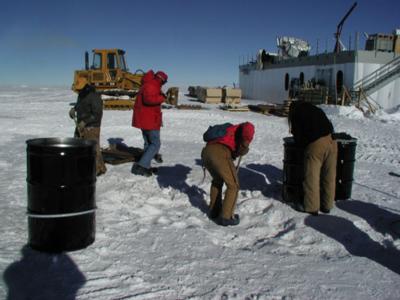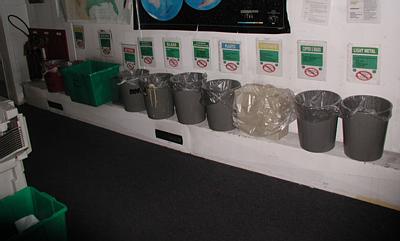
|
|
28 December, 2000
Environmental Control
Today while Ed Pernic and I were finishing another coldhead, one of the
cranes came by the dark sector to lift a few things onto MAPO and AST/RO.
Shortly after they were done, the crane started to leak hydraulic fluid
into the snow. This, of course, is no good. Immediately, the crane
operators gathered containers to collect the liquid, and they eventually
got the crane to the garage to be fixed. But, this left a lot of
hydraulic fluid in the snow which needed to be cleaned up.

The hydraulic fluid did not get more than a few inched into the snow before it froze, so the clean up was not as bad as it might have been in warmer climates. The rest of the day, dirty snow was shoveled into barrels labeled “hydraulic fluid contaminated snow” that will be shipped back to the United States for disposal. This leads one to ask the question, what happens to garbage produced here?

Antarctica is a unique environment, and we want to minimize our impact on it as much as possible. All waste at the south pole is sorted into 16 categories: aluminum cans, batteries (Ni/Cad, Lithium, mercury and unknown, alkaline), bio waste, burnables, cardboard, clothing, construction debris, food waste, florescent light bulbs, glass, human waste, light metal, magazines and newspaper, plastic, white paper, and wood. Whatever can be reused is frequently removed from the bins, parcticularly clothing. There are also subcategories, and other smaller categories for hazardous waste and accidents like the hydraulic fluid spill. Since everything that is brought here must be eventually brought back out, everyone is conscious of reducing waste as much as possible, and reusing whatever they can. Whatever cannot be reused is separated, and 70% of waste from the South Pole is recycled. From here, our waste gets flown to McMurdo, where is it sorted through again and added with the waste from McMurdo. Most of it is then shipped to Washington state for recycling and disposal.
Contact the TEA in the field at
.
If you cannot connect through your browser, copy the
TEA's e-mail address in the "To:" line of
your favorite e-mail package.
|
